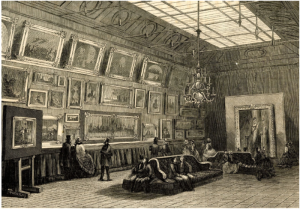Casa-Museu Medeiros e Almeida, Lisbon, Portugal, November 2 – 03, 2020
Deadline: Feb 15, 2020
The present conference seeks to counteract the frequent tendency of scholars of art market studies to mainly focus their attention on collectors, rather than on suppliers and intermediaries. In this spirit, we urge researchers to reflect upon the generic idea according to which these art market players are all the more powerful because they have a multinational presence, specifically various branches in several countries.
For example Christie’s and Sotheby’s, multinational corporations, now dominate the secondary art market, but we can also cite earlier examples such as the Parisian dealer Paul Durand-Ruel, who conquered America, the firm Goupil & Cie, the New Yorker Knoedler, who established himself on the European market, or Agnew’s, the Duveen brothers, the Islamic art dealer Dikran Kelekian and, for Asian art objects, the firm Yamanaka & Co.
The purpose of this conference, therefore, is to question this rule of thumb, according to which the leaders of the art market are also those who have been able to conquer foreign countries and who also own several branches of their business. The papers selected will preferably cover the period from 1800, after the disintegration of the Dutch East India Company, to the present day, and should take into account the following points.
1. What is “market power”? A first methodological issue concerns defining what is called « market power » in the case of the art market, and to measure it. Market power can be analysed from an economic but also a sociological point of view, as a “power of prescription”, i.e. the ability to define what/who is valuable. Are the actors with the highest turnover also those with the most significant prescribing power? How to integrate the consideration of a multinational presence or several branches in this definition and measurement?
2. Who are the leaders in the art market? The criteria above can help identifying the main actors in the art market, whether for fine arts, decorative arts, non-European artefacts, etc., focusing on suppliers and intermediaries rather than only on collectors and artists. These monographic approaches should be substantiated, ex-ante, by a more macroeconomic analysis, to justify why the analysed actor is a market leader. Are the leaders identified the ones with multiple branches or with a presence in various countries, both temporary or permanent? And if not, who are they really?
3. What are the implementation strategies of the actors? The papers addressing this issue will seek to distinguish the geographical strategies of market players, and may be based on case studies. Why do some actors seek to expand their business abroad? What are the trade-offs to be taken into account in the art market? How does an actor open a branch in a very concrete way? What networks are mobilized? Is the artistic offer the same in all branches? Similarly, do the prices charged vary and, if so, in which direction?
Where and when?:
Casa-Museu Medeiros e Almeida, Lisbon, Portugal
November 2-3, 2020
Important dates:
February 15, 2020: Proposals submission
April 2020: Note of acceptance
December 18, 2020: Full paper submission
Organisation:
ARTIS – Institute of Art History, School of Arts and Humanities, University of Lisbon
École Normale Supérieure (Paris)
Organising Committee:
Vera Mariz – ARTIS – Institute of Art History, School of Arts and Humanities, University of Lisbon
Léa Saint-Raymond – École Normale Supérieure (Paris)
Scientific Committee:
Adelaide Duarte – Instituto de História da Arte, NOVA/FCSH
Agnès Penot-Lejeune – Independent Researcher
Christian Huemer – Belvedere Research Center
Cléa Patin – Université Jean Moulin Lyon 3
Diana J. Kostyrko – RSHA, Australian National University
Elizabeth Pergam – Sotheby’s Institute of Art
Filip Vermeylen – Erasmus University Rotterdam
Frances Fowle – Edinburgh College of Art
Maria João Baptista Neto – ARTIS – Institute of Art History, FLUL
Marta Perez-Ibanez – Independent Researcher
Natasha Degen – FIT, State University of New York
Sandra van Ginhoven – Getty Research Institute
Yaëlle Biro – The Metropolitan Museum of Art
We welcome papers on the conference topics and other themes of general interest to the field.
The language of the conference will be English and the submissions should include:
– Title of the proposal;
– Identification of the applicant: name, institutional affiliation, country and e-mail;
– Abstract of 400 words or less;
– Short professional bio up to 100 words.
All proposals must be submitted in Word format to conference.beyondborders@gmail.com with vera.mariz@letras.ulisboa.pt and lea.saint-raymond@ens.fr in cc.
The proposed contributions will be reviewed and a selection will be made by the Scientific Committee, through a double-blind review process. All accepted papers will be published in a book.


Leave a Reply
You must be logged in to post a comment.